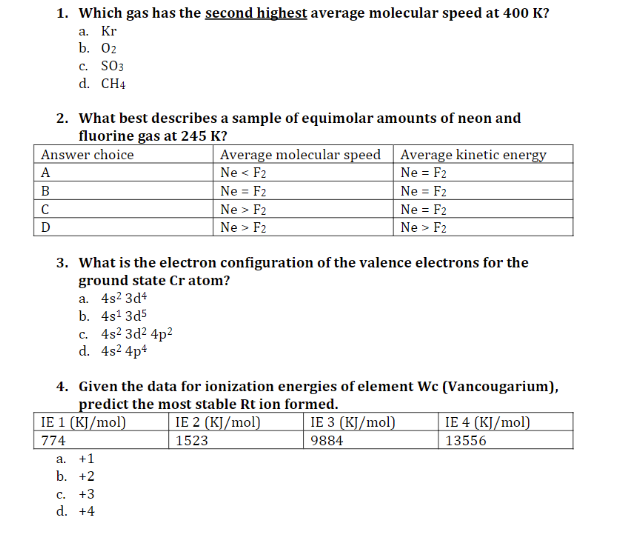1. Which gas has the second highest average molecular speed at 400 K? а. Kr b. 02 c. SO3 d. CH4 2. What best describes a sample of equimolar amounts of neon and fluorine gas at 245 K? Answer choice Average molecular speed Average kinetic energy Ne = F2 Ne = F2 A Ne < F2 В Ne = F2 Ne > F2 Ne = F2 D Ne > F2 Ne > F2 3. What is the electron configuration of the valence electrons for the ground state Cr atom? a. 4s2 3d+ b. 4s1 3d5 c. 4s2 3d2 4p2 d. 4s2 4p+
1. Which gas has the second highest average molecular speed at 400 K? а. Kr b. 02 c. SO3 d. CH4 2. What best describes a sample of equimolar amounts of neon and fluorine gas at 245 K? Answer choice Average molecular speed Average kinetic energy Ne = F2 Ne = F2 A Ne < F2 В Ne = F2 Ne > F2 Ne = F2 D Ne > F2 Ne > F2 3. What is the electron configuration of the valence electrons for the ground state Cr atom? a. 4s2 3d+ b. 4s1 3d5 c. 4s2 3d2 4p2 d. 4s2 4p+
Chemistry: Principles and Reactions
8th Edition
ISBN:9781305079373
Author:William L. Masterton, Cecile N. Hurley
Publisher:William L. Masterton, Cecile N. Hurley
Chapter5: Gases
Section: Chapter Questions
Problem 70QAP: Given that 1.00 mol of neon and 1.00 mol of hydrogen chloride gas are in separate containers at the...
Related questions
Question

Transcribed Image Text:1. Which gas has the second highest average molecular speed at 400 K?
а. Kr
b. 02
c. SO3
d. CH4
2. What best describes a sample of equimolar amounts of neon and
fluorine gas at 245 K?
Answer choice
Average molecular speed Average kinetic energy
Ne = F2
Ne = F2
A
Ne < F2
В
Ne = F2
Ne > F2
Ne = F2
D
Ne > F2
Ne > F2
3. What is the electron configuration of the valence electrons for the
ground state Cr atom?
a. 4s2 3d+
b. 4s1 3d5
c. 4s2 3d2 4p2
d. 4s2 4p+
4. Given the data for ionization energies of element Wc (Vancougarium),
predict the most stable Rt ion formed.
ΙE 1 (K1/mol)
IE 2 (KJ/mol)
IE 3 (KJ/mol)
IE 4 (KJ/mol)
ЕЗ
774
1523
9884
13556
a.
+1
b. +2
C.
+3
d. +4
Expert Solution
This question has been solved!
Explore an expertly crafted, step-by-step solution for a thorough understanding of key concepts.
This is a popular solution!
Trending now
This is a popular solution!
Step by step
Solved in 2 steps with 2 images

Knowledge Booster
Learn more about
Need a deep-dive on the concept behind this application? Look no further. Learn more about this topic, chemistry and related others by exploring similar questions and additional content below.Recommended textbooks for you

Chemistry: Principles and Reactions
Chemistry
ISBN:
9781305079373
Author:
William L. Masterton, Cecile N. Hurley
Publisher:
Cengage Learning

Physical Chemistry
Chemistry
ISBN:
9781133958437
Author:
Ball, David W. (david Warren), BAER, Tomas
Publisher:
Wadsworth Cengage Learning,

Chemistry for Engineering Students
Chemistry
ISBN:
9781337398909
Author:
Lawrence S. Brown, Tom Holme
Publisher:
Cengage Learning

Chemistry: Principles and Reactions
Chemistry
ISBN:
9781305079373
Author:
William L. Masterton, Cecile N. Hurley
Publisher:
Cengage Learning

Physical Chemistry
Chemistry
ISBN:
9781133958437
Author:
Ball, David W. (david Warren), BAER, Tomas
Publisher:
Wadsworth Cengage Learning,

Chemistry for Engineering Students
Chemistry
ISBN:
9781337398909
Author:
Lawrence S. Brown, Tom Holme
Publisher:
Cengage Learning

Introduction to General, Organic and Biochemistry
Chemistry
ISBN:
9781285869759
Author:
Frederick A. Bettelheim, William H. Brown, Mary K. Campbell, Shawn O. Farrell, Omar Torres
Publisher:
Cengage Learning

Chemistry
Chemistry
ISBN:
9781305957404
Author:
Steven S. Zumdahl, Susan A. Zumdahl, Donald J. DeCoste
Publisher:
Cengage Learning

Chemistry: An Atoms First Approach
Chemistry
ISBN:
9781305079243
Author:
Steven S. Zumdahl, Susan A. Zumdahl
Publisher:
Cengage Learning